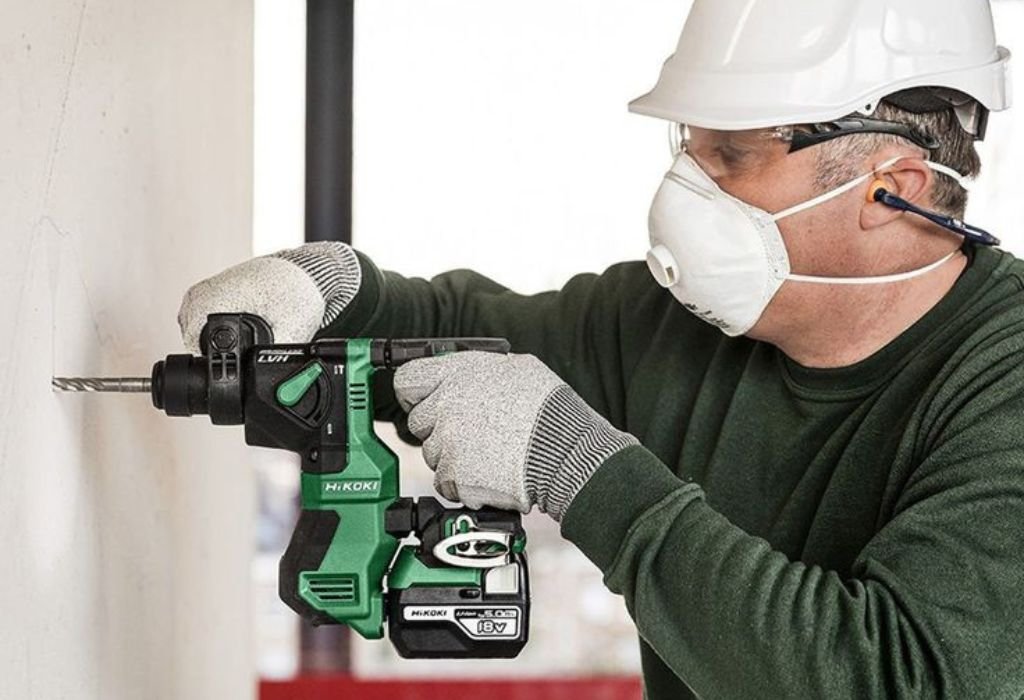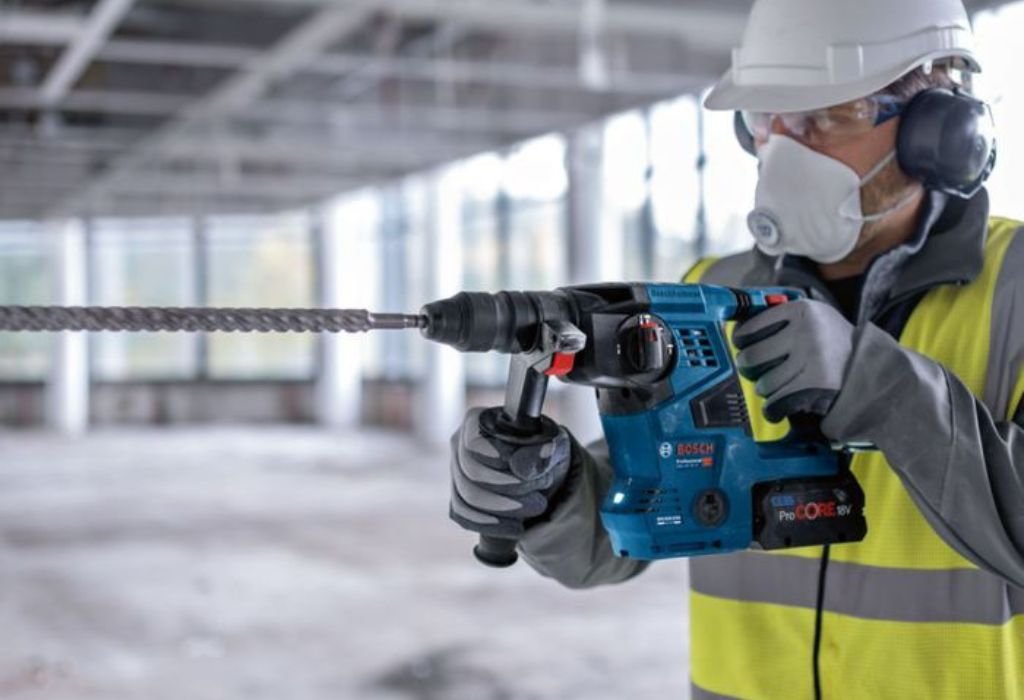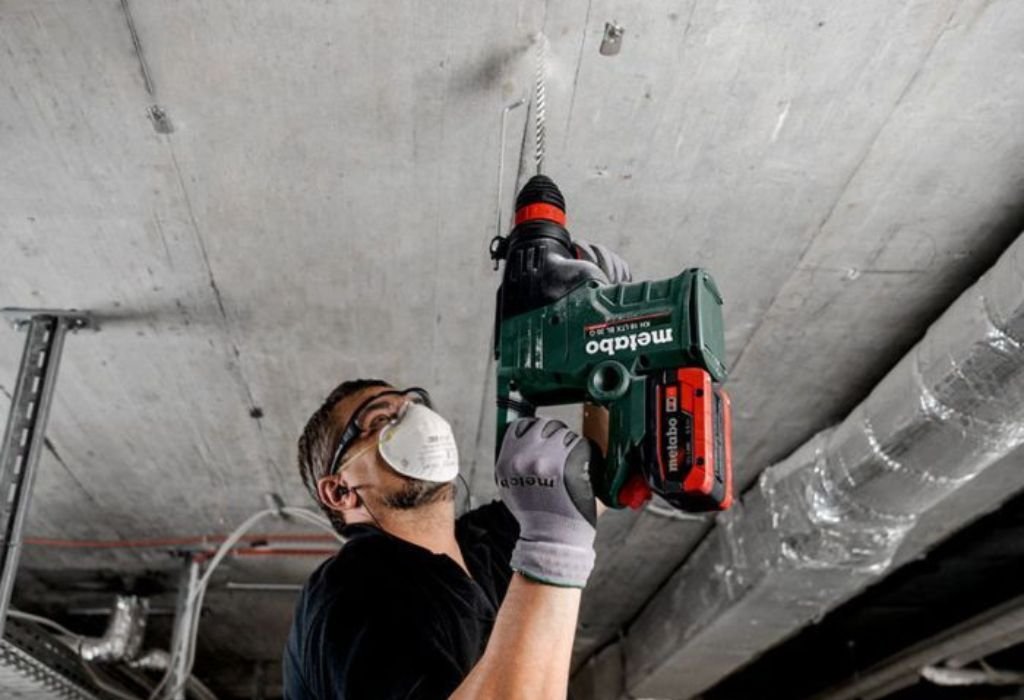On a construction site, the sound of rotary hammers echoes as workers bore through thick concrete.
New users often make the same mistake—leaning their full weight onto the tool, believing more pressure means faster drilling.
The result is fatigue, slower progress, and even damaged bits.
Rotary hammers are engineered differently from standard hammer drills. Instead of relying on user force, they generate power through an electropneumatic piston system that delivers thousands of blows per minute.
This technology allows the tool to break concrete with minimal pressure, letting the hammering action do the heavy work.
Statistics show that proper drilling technique can extend bit life by more than 30%, while also improving efficiency (Bosch Tools).
Over-pressing, on the other hand, reduces impact energy and increases motor wear. This simple misunderstanding costs workers both time and money on the job.
The curiosity many DIYers and professionals share is simple: how much pressure is enough? The answer is surprisingly light.
A rotary hammer works best with steady, controlled feed pressure that keeps the bit engaged without stalling the mechanism. This technique not only protects the tool but also ensures cleaner, faster holes.
Understanding whether to push down on a rotary hammer is more than a matter of comfort—it’s essential for efficiency, safety, and extending the lifespan of both tool and accessories. This guide explores the exact pressure required, common mistakes, and the techniques professionals use to let the rotary hammer perform at its full potential.
Quick Answer — How Much Pressure a Rotary Hammer Actually Needs

A rotary hammer generates its own impact energy through an internal piston system. This means only light pressure is required to keep the bit engaged while the tool does the heavy lifting.
Excess pressure restricts the bit’s travel, lowers blows per minute, and causes overheating. The right method is to hold the tool firmly, apply consistent feed, and let the hammering do the cutting.
Do I need to push down on a rotary hammer?
Only light pressure is needed; let the hammer mechanism do the work.
How much force is ideal?
About the pressure of a firm handshake, enough to keep the bit steady without forcing it.
What happens if I push too hard?
Excess pressure reduces blows per minute, overheats the tool, and damages the bit.
Does pushing harder speed up drilling?
No, it actually slows drilling and increases fatigue.
Is the pressure different from a hammer drill?
Yes, hammer drills rely on user force, but rotary hammers do not.
Rotary Hammer Basics — Why Pushing Hard Works Against the Tool
Inside the Tool: Electropneumatic Piston & BPM
Rotary hammers use an electropneumatic piston that compresses air to deliver percussive energy to the bit. This mechanism is far stronger than any user-applied force.
SDS Shanks & Bit Retention
SDS-Plus and SDS-Max shanks allow the bit to move axially so impact energy transfers efficiently. Extra downward force reduces this movement and lowers performance.
What generates the impact energy?
An internal piston system, not the user’s body weight.
Does pushing reduce blows per minute?
Yes, extra pressure dampens the hammering action.
Why do SDS bits “float”?
Their slots allow movement for impact delivery.
Do larger hammers need more push?
No, they rely on bit type and impact energy, not force.
Is impact energy the same as torque?
No, impact energy is per-blow force measured in joules.
Technique Matters — Feed Pressure, Angle, and Dust Clearing
The Right Feed Pressure
Light pressure allows the bit to cut effectively. Over-pressure slows removal and overheats both tool and bit.
Feathering & Clearing the Flutes
Every few seconds, pause or lift slightly to let dust escape. This keeps cutting edges sharp and progress smooth.
How much pressure is “light”?
Enough to keep the bit engaged without stalling.
Why pause every few seconds?
To clear dust and maintain speed.
Does angle matter?
Yes, drilling at 90° prevents side stress and spalling.
What if the hole stalls?
Back off, clear dust, and restart with gentle pressure.
Should I use a vacuum?
Yes, dust extraction improves drilling speed and extends bit life.
Modes & Materials — Choosing the Right Setting
Concrete, Masonry, and Stone
Hammer-drill mode is best for boring holes in concrete or masonry. Hammer-only mode is suited for chiseling tasks like tile removal.
Rebar Encounters
If you hit rebar, stop immediately and use a rebar cutter or relocate the hole.
Do I push harder on hammer-only mode?
No, let the tool and chisel bit do the work.
What if I strike rebar?
Stop drilling and switch to a rebar cutter.
Can drill-only mode work in concrete?
No, it burns bits; use hammer-drill mode.
Is stone harder than concrete?
Yes, many stones require slower feed rates.
Does tile need pressure?
Minimal, to avoid cracking the surface.
Bit Selection & Condition — Why It Matters

Matching the Bit to the Job
SDS-Plus is best for smaller holes, while SDS-Max handles large-diameter drilling. Choose 2-cutter or 4-cutter carbide heads based on the material.
Signs of Over-Pressure
Chipped tips, polished flutes, or blueing indicate pushing too hard.
Will a fresh bit need less push?
Yes, sharp carbide drills with minimal effort.
Do larger bits need more pressure?
Slightly, but still far less than hammer drills.
How often should bits be replaced?
When progress slows or carbide is damaged.
Are 4-cutter bits better for rebar?
Yes, they resist jamming when hitting steel.
Do cheaper bits require more force?
Often yes, due to weaker carbide.
Ergonomics & Safety — Work Smarter, Not Harder
Body Position & Vibration Control
Stand balanced, use the side handle, and let vibration-reduction features minimize fatigue.
PPE & Dust Safety
Always wear eye, ear, and respiratory protection when drilling concrete.
Is leaning on the tool safe?
No, it increases fatigue and risk of kickback.
How to reduce fatigue?
Use neutral posture, side handles, and light feed.
Do I need hearing protection?
Yes, rotary hammers are loud tools.
Why care about silica dust?
Concrete dust is hazardous and requires controls.
Does the side handle matter?
Yes, it ensures alignment without extra push.
Common Mistakes — Why People Push Too Hard
Start-Up Errors
Skating bits or spalling edges often happen when users push too soon.
In-Hole Errors
Forcing through aggregate or ignoring dust build-up slows drilling.
Why does the bit wander?
Too much force at start or no starter punch.
Why is concrete spalling?
Pushing hard near edges or wrong angle.
Why is drilling slow?
Dull bits or excess pressure.
Why are holes oversized?
Side pressure creates wobble.
How to prevent blowout on the backside?
Feather the last centimeters gently.
Troubleshooting Slow Drilling
Setup Check
Confirm correct mode, SDS seating, and bit condition before increasing force.
Technique Check
Back off pressure, clear dust, and drill at the correct angle.
Why does the tool stall?
Over-pressure or bit binding.
Why won’t the bit advance?
Dull carbide or rebar blockage.
Why does the tool sound flat?
Too much push lowers BPM.
Why does dust pile up?
No extraction or flute clearance.
How to handle hard aggregate?
Use a smaller pilot hole or 4-cutter bit.
Accessories That Help You Push Less
Dust Extractors & Guides
On-board extraction clears debris and reduces effort.
Depth Stops & Rebar Cutters
Keep feed consistent and prevent damage.
Is a depth stop useful?
Yes, it prevents overdrilling.
Do core bits need force?
Only light feed pressure.
Will a rebar cutter save bits?
Yes, it avoids carbide breakage.
Do vacuum systems speed drilling?
Yes, by keeping flutes clear.
Are guide jigs needed overhead?
Yes, they help alignment and reduce strain.
Maintenance — The Secret to Easier Drilling

Greasing & Cleaning
Keep SDS chucks lubricated and bits clean for smoother action.
Tool Health
Service the hammer if impacts weaken or overheating occurs.
Does a dry chuck hurt performance?
Yes, it increases friction and feed effort.
How often should grease be applied?
As per the manufacturer’s manual.
Can dull bits harm the tool?
Yes, they force excess push.
When to service the hammer?
When impact power drops noticeably.
Do batteries affect feed pressure (cordless models)?
Yes, weak batteries lower BPM.
Conclusion — The Right Way to Drill with a Rotary Hammer
The clear answer to “do I need to push down on a rotary hammer” is simple: apply only light, steady pressure and let the tool’s mechanism deliver the blows. Correct technique ensures faster drilling, less fatigue, and longer tool life.
Choosing the right bit, using dust extraction, and keeping the tool maintained all contribute to efficiency. With proper technique, even dense concrete can be drilled smoothly without excessive effort.
What’s the golden rule for pressure?
Steady contact, minimal push, maximum efficiency.
How to drill faster today?
Use sharp bits, dust extraction, and let the hammering action work.
What’s the most common mistake?
Leaning body weight on the tool.
What’s the benefit of correct technique?
Cleaner holes, longer bit life, and less fatigue.
Final takeaway?
Work smarter, not harder—rotary hammers are built to hammer for you.

I’m John F. Nicholas, the founder, lead writer, and drill enthusiast behind 101drill.com. With years of hands-on experience in power tools and DIY projects, I created this platform to share practical knowledge, expert tips, and real-world insights to help others master the art of drilling.
